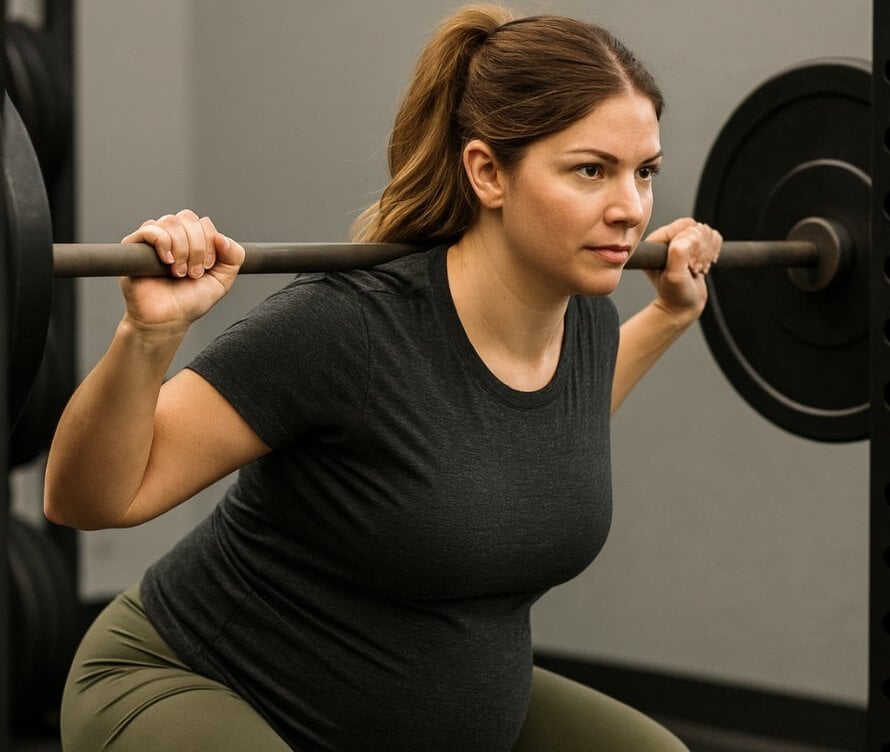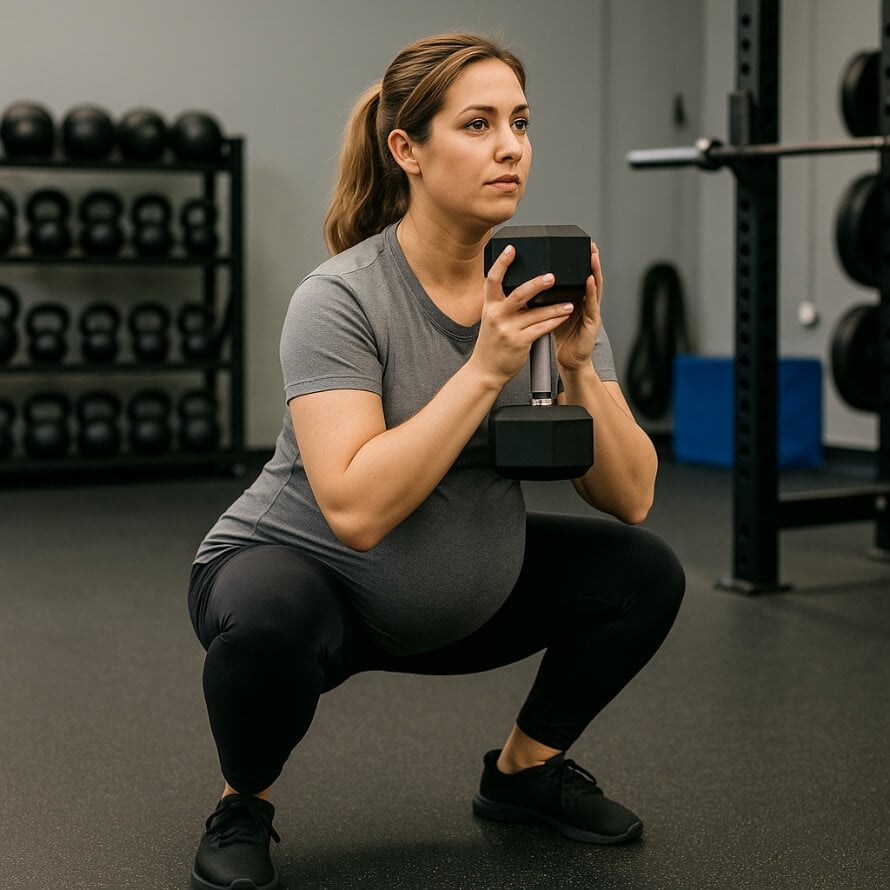Can You Lift Weights While Pregnant? What Science Actually Says
If you’re an expectant mother who’s into fitness, you’ve probably wondered: Can you lift weights while pregnant?
And not just that.
You’ve probably also asked yourself questions like how much weight you can lift when pregnant, whether lifting heavy things in the first, second, or third trimester is dangerous, and if you should stop strength training altogether.
You can Google these questions—but the problem is that most of the advice out there is inconsistent, outdated, or based on guesswork, not on actual research about lifting during pregnancy.
The good news?
We finally have studies that give a much clearer picture of what’s safe, what isn’t, and how much you can lift while pregnant in a healthy, uncomplicated pregnancy.
This guide explains everything you need to know.
Key Takeaways
- Yes, you can lift weights while pregnant. In healthy, uncomplicated pregnancies, strength training is safe and provides major benefits for both you and your baby.
- Some women need medical clearance first. Conditions like placenta previa or preeclampsia require a conversation with your healthcare provider before lifting.
- Moderate-intensity training is the sweet spot. Train your whole body 2–3 times per week, use weights you can lift for 10–15 controlled reps (about 60–70% of your one-rep max) per set, and stop each set roughly 3 reps shy of failure.
- Heavy lifting is safer than we once thought—but not necessary. New studies show women can safely handle heavier loads (~75% of one-rep max), but pregnancy isn’t the time to chase PRs.
- Stop lifting and contact your provider if you notice any warning signs. These include vaginal bleeding, dizziness, chest pain, fluid leakage, contractions, or decreased fetal movement.
- Can You Lift Weights While Pregnant?
- Who Should Talk to Their Doctor Before Lifting Weights in Pregnancy
- Benefits of Lifting Weights While Pregnant
- How Pregnancy Changes the Way You Lift Weights
- How Much Weight Can You Safely Lift While Pregnant?
- General Strength-Training Guidelines for Pregnant Lifters
- Safe Strength-Training Exercises During Pregnancy
- Signs You Should Stop Lifting and Speak to Your Doctor
- The Bottom Line on Can You Lift Weights While Pregnant?
- FAQ #1: What is the maximum weight you can lift while pregnant?
- FAQ #2: Can heavy lifting in early pregnancy cause miscarriage?
- FAQ #3: At what point in pregnancy should you stop lifting heavy weights?
- FAQ #4: Is it safe to start lifting weights for the first time while pregnant?
- FAQ #5: Can you keep lifting heavy if you were already training before pregnancy?
- Want More Content Like This?
Table of Contents
+Can You Lift Weights While Pregnant?
Yes—in most healthy, uncomplicated pregnancies, you can absolutely lift weights. Provided you follow a sensible program, research shows it’s not only safe for you and your baby, but actually highly beneficial for both of you.
That said, there are medical conditions and warning signs where lifting weights (or any structured exercise) might be unsafe or need tight supervision, and there are smart ways to tweak your program as your body changes.
So the real question isn’t “Can pregnant women lift weights?”—the answer to that is yes. The better question is who should be extra cautious, and how should you train to keep both you and your baby safe?
Who Should Talk to Their Doctor Before Lifting Weights in Pregnancy
Guidelines suggest you should avoid lifting weights during pregnancy—or at least until your doctor tells you it’s safe—if you have any of the following conditions:
Absolute Contraindications to Exercise During Pregnancy
| ● Hemodynamically significant heart disease |
| ● Restrictive lung disease |
| ● Incompetent cervix |
| ● Multiple gestation at risk for premature labor |
| ● Persistent vaginal bleeding |
| ● Placenta previa after 26 weeks |
| ● Premature labor during the current pregnancy |
| ● Ruptured membranes |
| ● Preeclampsia/pregnancy-induced hypertension |
Derived from guidelines provided by the Canadian Society for Exercise Physiology (Canadian Society for Exercise Physiology [CSEP]. Physical Activity Readiness Medical Examination for Pregnancy [PARmed-X for Pregnancy]. Available from CESP, Ottawa, Canada, 1996).

There’s also a second bucket of conditions where exercise might be fine, but you really shouldn’t just wing it on your own. In other words, none of the following automatically mean “no lifting,” but they do mean “have a detailed conversation with your doctor about what’s safe for you”:
Relative Contraindications to Exercise During Pregnancy
| ● Severe anemia |
| ● Unevaluated maternal cardiac arrhythmia |
| ● Chronic bronchitis |
| ● Poorly controlled type 1 diabetes |
| ● Morbid obesity |
| ● Extreme underweight (body mass index <12) |
| ● History of extreme sedentary lifestyle |
| ● Intrauterine growth restriction in current Pregnancy |
| ● Poorly controlled hypertension |
| ● Orthopedic limitations |
| ● Poorly controlled seizure disorder |
| ● Poorly controlled hyperthyroidism |
Derived from guidelines provided by the Canadian Society for Exercise Physiology (Canadian Society for Exercise Physiology [CSEP]. Physical Activity Readiness Medical Examination for Pregnancy [PARmed-X for Pregnancy]. Available from CESP, Ottawa, Canada, 1996).

So if you have any of the conditions above—or you’re just not sure where you fall—don’t guess. Talk to your OB-GYN, midwife, or primary care provider, tell them what kind of weightlifting you’d like to do, and use their guidance as your starting point.
In the rest of this article, we’ll assume you’ve had that conversation and been cleared for exercise, and we’ll focus on how to lift in a way that supports both your health and your baby’s.
Benefits of Lifting Weights While Pregnant
Studies on strength training during pregnancy have found benefits for moms like:
- Better energy levels and less fatigue
- Less lower back pain
- Better mood, confidence, and body image
- Better blood sugar control
- Less weight gain during pregnancy
Strength training during pregnancy may also help shorten early labor, lower the risk of C-section or other operative deliveries, and reduce some delivery complications.
And the benefits don’t stop with you. Research shows that resistance training during pregnancy can help your baby, too—by lowering the risk of being very large at birth (macrosomia), reducing newborn complications, and supporting healthy growth and development from birth into childhood.
How Pregnancy Changes the Way You Lift Weights
Pregnancy doesn’t just add a bump to the front of your body—it changes the way your whole body lines up and moves. That’s why exercise that used to feel automatic can suddenly feel awkward, wobbly, or just “off,” even if the weight on the bar hasn’t changed.
A lot of this comes down to three things:
- Your center of gravity shifting forward as your belly grows
- The curve in your lower back increasing
- Your joints becoming looser than usual
Those changes don’t mean you have to stop lifting—but they do change how you should think about technique, load, and exercise selection as pregnancy progresses.
Balance, Center of Gravity, and Joint Stability in Pregnancy
One of the main reasons exercises like squats and deadlifts (and their variations) feel different in pregnancy is that your lower back curves more and your center of gravity shifts forward. Together, these changes increase stress on your lower back and can throw off your balance.
At the same time, your joints are getting looser. Pregnancy hormones like relaxin make your ligaments more mobile, which can increase the risk of injury to muscles, joints, and ligaments.
From a training perspective, this combination explains why:
- You may feel less stable on your feet, especially as loads go up
- Your back may complain sooner, especially when training close to failure
- End-range, bouncy, or explosive movements are more likely to feel sketchy
That’s why most pregnancy-specific training guidelines recommend more controlled reps, lifting submaximal loads, and using meticulous technique. You’re not fragile—but your body is in a different place than it was pre-pregnancy, and your training must reflect that.
Pelvic Floor and Core Changes That Affect Lifting
Pregnancy puts a lot of extra work on your core and pelvic floor. You’re supporting a growing baby, more fluid, more bodyweight, and (eventually) the work of labor and delivery. It’s no wonder many women worry that lifting weights will “wreck” their pelvic floor, cause incontinence, or increase their risk of prolapse.
The research we have so far doesn’t support that fear, however. For example, in a study of almost 700 pregnant CrossFitters, researchers found that those who lifted heavy weights had the same kinds of pregnancies and pelvic floor health as those who didn’t lift.
That’s why experts generally recommend the opposite approach: instead of treating your pelvic floor and core as something fragile that must be protected from strength training, your program should intentionally strengthen these areas.
That means doing exercises that target your hips, glutes, and core, and choosing pelvic-floor-friendly movements that help prepare your body for labor, carrying your baby, and all the pushing, lifting, and awkward positions of postpartum life.
How Much Weight Can You Safely Lift While Pregnant?
Until recently, most experts told pregnant women to avoid lifting heavy. The worry wasn’t that strength training itself was harmful, but that pushing too hard might:
- Raise heart rate and blood pressure high enough to pull blood toward working muscles and away from the uterus
- Make the Valsalva maneuver (breathing and bracing) temporarily reduce cardiac output and blood flow to the placenta
- Put you in a supine position (like a flat bench press) where the uterus could press on the vena cava and reduce blood returning to the heart
The problem is that these were mostly educated guesses, not based on results from studies in which pregnant women lifted heavy weights under scientific observation. Now we have actual data—and it’s much more reassuring.
Alongside the CrossFit study mentioned earlier, two recent studies have tested heavy lifting directly.
The first, from the University of Alberta, brought 10 healthy pregnant lifters (late second trimester) and 10 non-pregnant lifters into the lab, all with at least two years of training experience. The women performed heavy barbell squats, bench press, and deadlifts, and used the Valsalva maneuver on some sets.
The results showed that the babies handled it all just fine: fetal heart rate didn’t change from pre- to post-exercise, and umbilical blood flow stayed normal.
The second, from the Norwegian School of Sports Sciences, tested 48 healthy pregnant athletes (late second and third trimester). Each woman did 3 sets of 8 reps of the sumo deadlift, flat bench press, and incline bench press at about 75% of her one-rep max, leaving one rep in the tank.
Throughout the study, fetal heart rate stayed in the normal range, umbilical artery blood flow didn’t change, and uterine artery blood flow improved slightly. There was one brief case of fetal bradycardia (slow fetal heart rate) and a few brief episodes of fetal tachycardia (high fetal heart rate), but they resolved on their own and blood flow remained normal.
Taken together, these studies suggest that healthy women can probably lift heavier during pregnancy than most guidelines used to allow—even if it involves the Valsalva maneuver and lying on your back.
That said, the point of pregnancy training isn’t to chase PRs or maximize muscle growth—it’s to stay strong and feel good—so lifting very heavy isn’t necessary. With that in mind, let’s look at some practical guidelines for training during pregnancy.
General Strength-Training Guidelines for Pregnant Lifters
When you look at the research as a whole, most of the benefits we see from lifting during pregnancy come from taking a moderate approach to strength training.
In practical terms, this usually means:
- Training each major muscle group 1–2 times per week
- Lifting weights 60–70% of your one-rep max, which should allow you to do 10–15 reps per set
- Ending sets when you’re about 3 reps shy of “failure” (the point when you can’t perform another rep with good form even if you try)
- Training for 40–60 minutes, 2–3 times per week
- Using proper form—no jerking or bouncing the weight, and no heaving your body around to get it up
This kind of training is enough to keep you strong and healthy without piling on unnecessary strain or risking injury.
Safe Strength-Training Exercises During Pregnancy
You don’t need a special list of “pregnancy-only” exercises—you can use all the usual tools: free weights, machines, cables, bands, and your own body weight. The main thing is that you feel stable and comfortable while performing them, and that you can maintain good form.
Some good exercise options for training your entire body include:
- Back squat
- Goblet squat
- Leg press
- Deadlift
- Sumo deadlift
- Trap-bar deadlift
- Romanian deadlift
- Overhead press
- Dumbbell shoulder press
- Bench press
- Dip
- Lat pulldown
- One-arm dumbbell row
A couple more notes to keep your training safe:
- If you’d prefer to skip supine exercises (especially later in pregnancy), choose dips or the machine chest press over the bench press for training your pecs.
- Because your balance and joint stability change as pregnancy progresses, it often makes sense to avoid single-leg exercises and prioritize more stable variations instead.
- Pace around between sets. Standing still can cause pooling of venous blood and can decrease cardiac output.
Signs You Should Stop Lifting and Speak to Your Doctor
Even in a healthy pregnancy, there are some symptoms that mean you should stop lifting right away and contact your doctor or midwife. This applies whether they show up during a workout or after you’ve finished.
If you notice any of these symptoms during or after lifting, get checked immediately:
- Vaginal bleeding
- Shortness of breath before you start exercising
- Dizziness or feeling faint
- Headache
- Chest pain
- Unusual muscle weakness
- Calf pain or swelling
- Signs of preterm labor (like regular contractions)
- Decreased fetal movement
- Leaking amniotic fluid
The Bottom Line on Can You Lift Weights While Pregnant?
For most healthy women, lifting weights during pregnancy isn’t just safe—it’s one of the best things you can do for your body and your baby. The key is getting clearance from your healthcare provider, training with good form, avoiding very intense training, and choosing exercises you can perform comfortably.
Done this way, lifting can keep you strong, energetic, and confident throughout pregnancy—and make labor, delivery, and postpartum life noticeably easier.
FAQ #1: What is the maximum weight you can lift while pregnant?
There’s no universal “maximum safe weight,” because what’s safe depends on your training experience, health status, symptoms, and so on. That said, pregnancy isn’t the time to chase PRs. Most women do best lifting moderate weights with perfect form.
FAQ #2: Can heavy lifting in early pregnancy cause miscarriage?
Research shows that moderate-intensity strength training doesn’t increase miscarriage risk in healthy, uncomplicated pregnancies. Still, if you have any concerns, talk to your healthcare provider before beginning or continuing a program.
FAQ #3: At what point in pregnancy should you stop lifting heavy weights?
There’s no specific week where everyone needs to stop lifting heavy. Instead, it depends on your symptoms, comfort level, and your doctor’s guidance.
FAQ #4: Is it safe to start lifting weights for the first time while pregnant?
Yes—starting a low- or moderate-intensity strength program during pregnancy has repeatedly been shown to be safe and beneficial for healthy beginners.
Research shows improvements in blood sugar control, weight gain, delivery outcomes, and overall well-being. Just be sure to get cleared by your doctor before starting.
FAQ #5: Can you keep lifting heavy if you were already training before pregnancy?
Yes—if you’re healthy and cleared to exercise, studies show that experienced weightlifters can often tolerate heavy weightlifting while pregnant without harming themselves or their babies.
Want More Content Like This?
Check out these articles:
- Diastasis Recti Exercises: Everything You Need to Know About How to Fix Diastasis Recti
- The Definitive Guide on How to Create a Pregnancy Meal Plan
- The Complete Guide to Postpartum Weight Loss
- The Best Postpartum Workout Plan for Full-Body Strength
- Mom Butt: How to Get Rid of a Flat Butt After Pregnancy
The post Can You Lift Weights While Pregnant? What Science Actually Says appeared first on Legion Athletics.
https://ift.tt/zTUda10 November 27, 2025 at 07:00PM Legion Athletics




Comments
Post a Comment